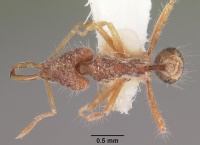Strumigenys hekate
| Strumigenys hekate | |
|---|---|

| |
| Scientific classification | |
| Kingdom: | Animalia |
| Phylum: | Arthropoda |
| Class: | Insecta |
| Order: | Hymenoptera |
| Family: | Formicidae |
| Subfamily: | Myrmicinae |
| Tribe: | Attini |
| Genus: | Strumigenys |
| Species: | S. hekate |
| Binomial name | |
| Strumigenys hekate Bolton, 2000 | |
Nothing is known about the biology of Strumigenys hekate.
Identification
Bolton (2000) - A member of the doriae complex in the Strumigenys doriae-group. For differentiation of species see under Strumigenys bryanti and Strumigenys doriae.
Keys including this Species
Distribution
Distribution based on Regional Taxon Lists
Indo-Australian Region: Borneo (type locality), Indonesia, Malaysia.
Distribution based on AntMaps
Distribution based on AntWeb specimens
Check data from AntWeb
Countries Occupied
| Number of countries occupied by this species based on AntWiki Regional Taxon Lists. In general, fewer countries occupied indicates a narrower range, while more countries indicates a more widespread species. |

|
Estimated Abundance
| Relative abundance based on number of AntMaps records per species (this species within the purple bar). Fewer records (to the left) indicates a less abundant/encountered species while more records (to the right) indicates more abundant/encountered species. |

|
Biology
|
Castes
Nomenclature
The following information is derived from Barry Bolton's Online Catalogue of the Ants of the World.
- hekate. Strumigenys hekate Bolton, 2000: 776 (w.) BORNEO.
Unless otherwise noted the text for the remainder of this section is reported from the publication that includes the original description.
Description
Worker
Holotype. TL 4.0, HL 1.07, HW 0.70, CI 65, ML 0.59, MI 55, SL 0.62, SI 89, PW 0.46, AL 1.10. Mandible with two minute preapical denticles, both in the distal half. In anterior view apical fork of mandible forming a V-shape or very narrow-based U-shape, the dorsal fork tooth conspicuously longer than the ventral. Pronotal humeri in dorsal view distinctly angulate. Lateral spongiform lobe of petiole a short collar, restricted to posterior margin of node, not extending forward to the level of the spiracle on the peduncle. Dorsolateral margin of head with 5 or more long fine hairs and a number of shorter simple hairs that freely project laterally; apicoscrobal hair usually slightly longer than any of the other main projecting hairs, its length about 0.40 X SL. With head in profile erect hairs that arise from the dorsum in front of the highest point of the vertex are much shorter than the longest hairs that arise between the highest point and the occipital margin; the longest of the latter is shorter than the maximum depth of the head capsule. Longest hairs on first gastral tergite shorter than length of tergite from base of limbus to apex, shorter than the maximum depth of the first gastral segment in profile. Surface of first gastral tergite with a coat of short grey appressed pubescence.
Type Material
Holotype worker, Malaysia: Sabah, Poring Hot Springs, Langanan Riv., 850 m., 14.v.1987, no. 25a (Lobl & Burckhardt) (Musee d'Histoire Naturelle Genève).
References
- Bolton, B. 2000. The ant tribe Dacetini. Memoirs of the American Entomological Institute. 65:1-1028. (page 776, worker described)
References based on Global Ant Biodiversity Informatics
- Pfeiffer M.; Mezger, D.; Hosoishi, S.; Bakhtiar, E. Y.; Kohout, R. J. 2011. The Formicidae of Borneo (Insecta: Hymenoptera): a preliminary species list. Asian Myrmecology 4:9-58

